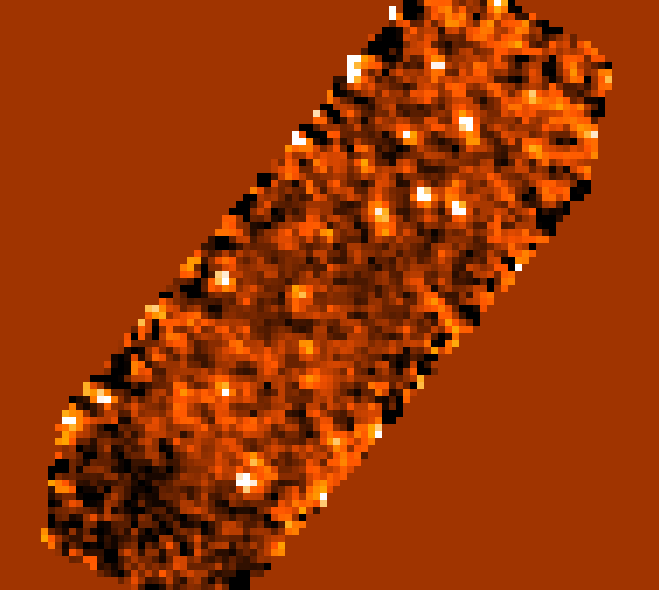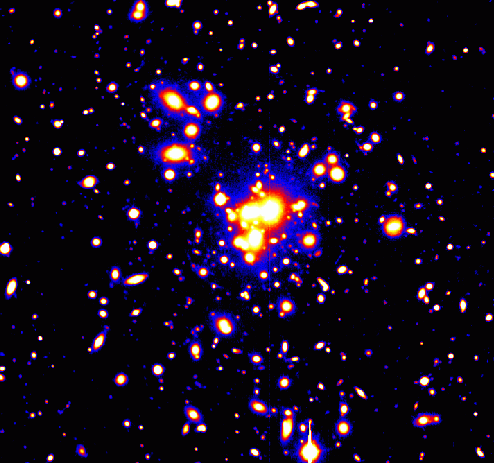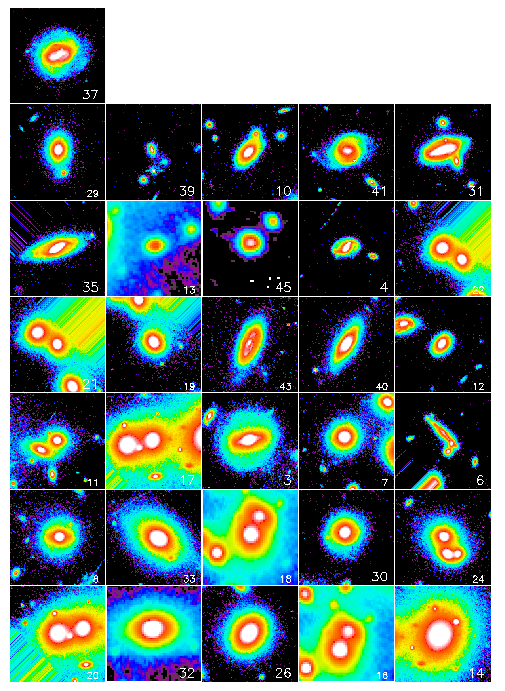
Using the ISOCAM camera working at wavelengths higher than 10 microns, SAp scientists and their colleagues discovered that galaxies of the cluster Abell 1689 host star-formation regions which are partially or totally enshrouded in dust. For galaxies detected at 15 microns, the total star formation rate is on average ten times higher than that estimated from usual indicators calibrated in the optical. Compared to those of Abell 1689, galaxies in nearby clusters form stars at much more moderate rates and in a more 'visible' way. The presence of hidden star-forming regions in distant clusters, if confirmed, reflects a more general change in the properties of galaxies with time. Such an evolution is known from the mid 80s as the Butcher-Oemler effect, after the names of those who first found it. The researchers of Saclay and their collaborators have for the first time enlighted it in the infrared.
Stars are born, live and die: this was established since long in the field of stellar astronomy. For thirty years, astronomers have also observed that, at their own scales, galaxies are formed, transformed and may be destroyed. If the evolution of stars mainly results from internal processes - the progressive exhaustion of gas fueling nuclear reactions - galaxy evolution is above all driven by external events. Among the hazards of a galaxy life, collisions play a major role. Slow encounters and mergers between galaxies have a dramatic effect on their morphology; fast and multiple collisions cause a secular evolution ('galaxy harassment'); chocks occur in gas clouds within galaxies plunging at high speed in a dense intergalactic medium. Such environmental effects are aggravated in rich clusters because of their high densities. The concentration of X-ray emitting hot intracluster medium adds to the accumulation of galaxies. It follows that galaxies located inside clusters evolve more rapidly than those outside ("in the field"). Clusters themselves are dynamical structures which form and evolve gradually. Therefore because their global characteristics change and in particular because their density increases, the impact of environmental effects on the properties of cluster galaxies increases with time. The Butcher-Oemler effect itself corresponds to an increase in the proportion of blue cluster galaxies as a function of redshift. Two other evolution effects were found: an increase of the proportion of spiral galaxies (morphological Butcher-Oemler effect) and of galaxies with an optical spectrum exhibiting signs of active or past star formation (spectroscopic Butcher-Oemler effect). Basically, nearby clusters, i.e. old ones, are mainly made of lazy elliptical galaxies not willing to form stars, while distant clusters, i.e. young ones, contain mainly gas-rich active spirals that recently fell in the cluster and that hence have not yet been too much affected by the cluster environment. The intra-cluster medium and the galaxy collisions contribute to eventually slow or even stop the star formation activity in newly arrived galaxies, that are stripped of their gas reservoir. However specialists in distant clusters fight on the following question: before suffocating, do galaxies trapped in the cluster environment exhibit a last starburst that would rapidly exhaust them ? Indeed, it is straitforward to imagine - and models predict it - that the shock of their interstellar medium against the intracluster gas creates instabilities and further causes the collapse of gas clouds and thus star formation. However the detailed study of field perturbed galaxies indicate that such an activity often takes place below a dust layer that only X-ray, infrared or radio telescopes can penetrate.
| Saclay astronomers and their collaborators have probed this dust enshrouded star formation activity through the infrared window. Using the camera ISOCAM , on board the ISO satellite, which was partly built at Saclay, they mapped at 7 and 15 microns about ten rich cluster of galaxies up to redshifts of 0.9. At that redshift lie clusters among the most distant and hence young known so far. Data reduction required several months of work and the development of new processing tools. The final infrared maps, such as the one shown here-above, do not look very nice, compared to the spectacular images produced by the Hubble Space Telescope, but in their own field, they are the deepest and most precise at our disposal for the moment. Thanks to the excellent sensibility of ISOCAM detectors, about one hundred galaxies emitting in the infrared were detected towards each cluster; this is much more than expected. |
 |
| ISOCAM image at 15 microns of the cluster J1888.16CL |
Now, one had still to check that these sources really belong to the cluster. Their identification and characterization required a long and laborious work. The good astrometric precision of ISOCAM made it easy to find their counterpart on optical images. Leur distance a été ensuite déterminée lors de plusieurs missions d'observations effectuée au Chili et à Hawaii. These were queried in the archives of several observatories such as ESO or HST. Distances were then determined during several observing runs in Chile and Hawaii. The NTT ( La Silla ), the VLT (Paranal ) and the CFH ( Mauna Kea ) telescopes were used among others. A multi-slit spectroscopy technique allowed to obtain the spectra of about thirty objects in a single exposure. The spectra not only provide a measure of the redshift, an indicator required to assess the cluster membership of a given source, but also precious piece of information on the nature of the infrared emitters. Are they perturbed starburst galaxies, more quiescient spirals or apparently passive ellipticals ?
This study first focussed on the most nearby cluster in the sample, Abell 1689. The results were recently published in the journal Astronomy & Astrophysics (*)
 |
The massive and rich cluster Abell 1689 is a well known by cosmologists. It was the subject of numerous studies and was even used as a gravitational telescope for observations of distant galaxies. Indeed it acts as a gravitational lens that magnifies the light of background sources which appear in deep optical images as arclets. Some of them are visible in the opposite image. |
| NTT image of the cluster of galaxies Abell 1689 |
| However ISOCAM has mostly detected genuine cluster galaxies. Selected from infrared observations, they are dusty objects; mainly spirals, some of them showing signs of a current interaction, as illustrated in the opposite figure, but also strangely enough a few elliptical or lenticular galaxies that are believed to contain small quantities of dust. Their optical spectra exhibit, for most of them, weak emission lines of ionized hydrogen and oxygen that are characteristics of a moderate star formation activity. Others do not exhibit such lines as if they were sterile. However their high 15 micron flux emitted by dust heated by young stars clearly indicates that they host star nurseries. It seems that in Abell 1689, 90% of the star formation activity is hidden inside dust cocoons. |
 |
|
Optical Hubble Space Telescope images of ISOCAM sources in the cluster of galaxies Abell 1689 |
So, do galaxies falling in clusters suffocate after loosing or consuming their gas reservoir ? A clear answer to this question is still premature. ISOCAM observations of Abell 1689 have shown that in this cluster galaxies still form stars at a relative high rate, but in a very discreet manner. The processing of the ISOCAM data on other clusters that are more distant and a priori more interesting is still going on.
Contact
Bibliography
(*) "Hidden star-formation in the cluster of galaxies Abell 1689"
Duc P.-A., Poggianti B.M., Fadda D., Elbaz D., Flores H., Chanial P., Franceschini A., Moorwood A. and Cesarsky C., 2002, A&A 382, 60 (article in PDF format 840kb)
"An excess of mid-IR luminous galaxies in Abell 1689 ?"
Fadda D., Elbaz D., Duc P.-A., Flores H., Franceschini A. and Cesarsky C., 2000, A&A 361, 827
